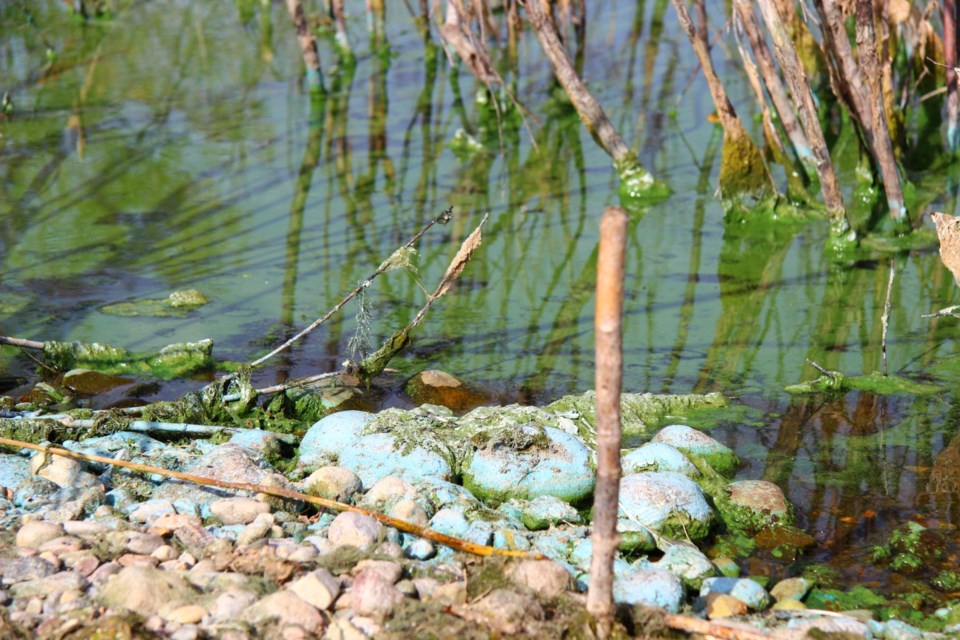BONNYVILLE – At least two dogs have been reported to have died as a result of suspected cyanobacteria (blue-green algae) poisoning from Moose Lake.
“There have been several reported fatalities of family pets due to contact with blue-green algae/ cyanobacteria in Moose Lake. If you see a bloom, do not enter into the water and prevent your pets from coming into contact with the bloom,” read a social media post from Moose Lake Watershed Society published on July 13.
So far this year, there has been no blue-green algae advisory placed on Moose Lake by Alberta Health Services (AHS).
“Beach monitoring itself happens on a nearly weekly basis, but it's at very specific locations. AHS only monitors on four sites at Moose Lake,” says Kellie Nichiporik, the chair of the Moose Lake Watershed Society.
Nichiporik received reports from community members that two canines had died in the hours and days after swimming in Moose Lake over the July 8-10 weekend.
The deaths of both animals are suspected to have been caused by consuming lake water containing cyanobacteria.
Despite the lack of a provincial health advisory, blue-green algae may still be present in Moose Lake but can be challenging to test for, says Nichiporik.
“Blue-green algae can move within the lake as well as stay in a very localized location. Also, based on when sampling occurs, blue-green algae can actually change its buoyancy, so it can appear in different parts of the water column at different times,” she explains.
“And so even if the person went up there and sampled, they could essentially miss it.”
Based on the recent reports of animal deaths suspected to be linked to cyanobacteria in Moose Lake’s water, increased monitoring by AHS could follow.
Lakeland This Week is awaiting comment from AHS on the matter.
Challenges with identifying cyanobacteria
To the untrained eye, determining if blue-green algae is present without proper testing can be challenging.
“Blue-green algae is an actually bacteria, it's not algae,” says Nichiporik. “Not everybody knows if it is blue-green algae just from looking at it because there are normal algae in the lake also. Really, without testing it can be hard to tell.”
She says despite the name, blue-green algae can be turquoise, green, brown, red, white or mixes of these colours.
Blue-green algae blooms can look like fine grass clippings in the water, spilled paint or pea soup. Sometimes blooms can look like thick scum on the surface.
The presence of cyanobacteria in the water and its visibility may also change depending on the weather.
"On a really sunny day, it might be lower down in the water column and so it's not always at the surface,” she says.
Blue-green algae blooms often smell musty or grassy when healthy and like ammonia when decomposing.
Reactions to Cyanobacteria
Cyanobacteria produce several different forms of toxins, some of which are lethal to humans and animals within minutes, while others that can bioaccumulate and cause long term damage to vital organs such as kidneys and liver.
Contact with blue-green algae blooms can also cause severe dermatitis (skin reactions) and flu-like symptoms such as fever, vomiting, nausea and diarrhea.
Volunteering to monitor Moose Lake
The Moose Lake Watershed Society is currently looking for community volunteers to help with a Microbial Source Tracking project by taking water samples from a wide variety of locations in and around Moose Lake.
The project overlaps with efforts to reduce blue-green algae blooms because the tracking of phosphorus sources helps to monitor how phosphorus is entering Moose Lake, whether from human septic, birds, or ruminants, says Nichiporik.
"Hopefully we can reduce those phosphorus inputs, which will hopefully reduce blue green algae blooms.”



